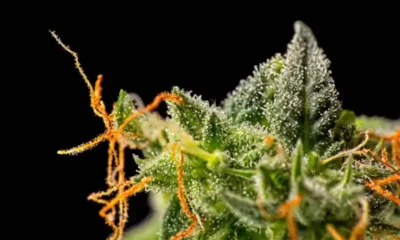News
The Absurdity of Halloween Sadism
Published
2 years agoon
By
Andrew Ward
For decades, community members, police, and media outlets have warned of the dangers of tampered Halloween candy. Razorblades, poison, and pot are all supposedly “threats” stuffed in treats this time of year. But is that actually the case?
Where Did The Pot-Laced Candy Myth Originate?
While few “Halloween sadism” cases have existed over several decades, most of the reports and claims are unsubstantiated. Some, including CNN, have pointed to Judy Klemesrud’s October 1970 New York Times article for spreading the narrative. For her article, Klemesrud spoke with then-New York Health Commissioner Dr. Hollis S. Ingraham, who encouraged parents to inspect all candy before eating. Dr. Hollis offered the advice based on alleged reports of pins, razorblades, glass slivers, and poison appearing in kids’ candies in recent years.
No matter the case, reporting like this has continued, spiking in specific years. Depending on the person asked, you may hear that cannabis has been part of this Halloween fear-mongering equation since the 1960s or 70s, aligning with the War on Drugs. Others, including most respondents that High Times spoke to for this article, report hearing of pot-laced Halloween candy around the time legalization began to spread across the U.S.
In 2017, Pennsylvania police helped kick off a new wave of cannabis concern when officers warned parents of pot-laced treats. The warnings from law enforcement and public leaders have continued since. Iowa and Massachusetts have been two of several examples of warnings during the holiday season.
Lauren Fontein, co-Owner of West Hollywood-based dispensary and delivery service The Artist Tree, said she began to hear about the rumors around 2016 or 2017. Operating an edibles line at the time, the mom of three didn’t want to see her products end up in kids’ hands.
“We made it a point to clearly label our products as cannabis-infused and include warning language and child-proof packaging at a time when it wasn’t yet required by law,” she said.
Scheril Murray Powell, Esq., COO of The JUSTÜS Foundation, also said she first heard the news in 2016.
“Some news coverage would show CBD products and indicate that people were trying to get kids high on CBD, which was not possible in those days because intoxicating CBD products were not on the market then,” she said.
Little to No Reports of Pot-Laced Halloween Sadism
For all the hubbub about Halloween sadism, there are few reports of any tampered-with candy. In 2000, the popular fact-checking site Snopes concluded that there was no truth to kids being given poisoned candy. However, that year, the site did confirm cases of Halloween treats with pins, needles, and razor blades inserted. Their research highlighted 1982 as the year the tempering myths took off. While alleged incidents had occurred since the late 50s, and tampering rumors had persisted for over a decade prior, poisoning incidents like the 1982 Tylenol murders in Chicago increased public fears during Halloween.
Twenty-one years later, Snopes revisited the topic, focusing on cannabis and Halloween candy. Their research found zero cases of pot-laced Halloween candy reports. Snopes claims that the first reports of pot-laced Halloween candy have been around since “at least 2010.”
A more authoritative source on Halloween sadism is retired University of Delaware sociology and criminal justice professor Joel Best. In his 1985 analysis, he and co-author Gerald T. Horiuchi concluded no child had died from any form of Halloween sadism after examining news reports from The New York Times, Los Angeles Times, Chicago Tribune and the Fresno Bee between 1958 and 1984.
In an update years later, Best detailed five documented cases of deadly Halloween sadism, with two cases linked to candy laced with heroin (1970) and cyanide (1974). The 1974 case is often cited as an example of deadly Halloween tampering. While true, the sadistic act did not involve a stranger killing a child, but rather a father murdering his son while attempting to kill several more children in the process. Another regularly cited example occurred in 1964, when Helen Pfeil of Greenlawn, New York, was arrested for giving poison and dog treats to trick-or-treaters she thought were too old to participate in the festivities.
Why Would Someone Dose Halloween Candy?
Some believe that public concern around Halloween rises if trouble occurs around the holiday. In 2019, Best told The Washington Post that difficult times in September can lead to additional Halloween concerns.
Halloween sadism is rare. Still, the occasional sadistic individual does live amongst us, either as a familiar face or an unknown entity. For decades, analysts have looked into a rare but startling trend of child abuse focused on non-accidental poisoning. In these cases, cannabis is not used but rather a chemical or more powerful drug. By 1982, researchers were calling the troubling incidents “an overlooked category of child abuse.” In 2003, research from the US Office of Justice Programs noted that intentional poisonings often stem out of form of extreme neglect, discipline, or Munchausen Syndrome by Proxy (MSBP), where child develop illnesses caused or induced by the parent or guardian.
Threats often come from in the home, but public concerns exist as well. A 2008 string of dog poisonings in Toronto’s High Park saw numerous dogs injured and two dead after ingesting water mixed with antifreeze. Similar incidents occurred across the nation. At that time, Tre Smith, an animal cruelty investigator for the Toronto Humane Society, suggested the act was committed by someone with “serious issues,” who likely didn’t enjoy sharing the park with the animals. He noted that it is difficult to identify the culprits.
In a 2012 Psychology Today article, Joni E Johnston Psy.D. said most poisoners are men between five and 10 years younger than their victims, often killing someone they already know. Johnston said there is much more to be revealed about the personality of a poisoner. Her hypothesis suggests someone using poison is a careful planner who is likely “cunning, sneaky, and creative.”
Still, this doesn’t explain why someone would use cannabis, an almost entirely non-lethal substance on anyone, stranger or familiar. With the plant most likely unable to kill or harm anyone, why would anyone waste their time or money on such a heinous act?
“In addition to the fact that offering cannabis-infused treats would be prohibitively expensive for most people in America, what would be the incentive for anyone to serve them,” asked Fruit Slabs edibles founder Brandon Dorsky.
The Artist Tree’s Fontein says she understands concerns about children being exposed to cannabis. “But it’s pretty unrealistic that an adult would want to hand out cannabis edibles to children since they cost much more than regular candy,” she said.
She added, “Contrary to what people may assume about cannabis consumers, we’re regular people with common sense and ethical values and aren’t out to trick little children.”
Fontein says she inspects candy regularly for unknown labels or damaged packaging to keep her kids safe.
Rather than focusing on laced Halloween candy, parents may want to be more concerned about confusing infused edibles with regular candies. While not prevalent, reports of kids bringing edibles to school intentionally or confusing infused options for typical sweets have been reported. And just like with anything a child may eat, parents should inspect ingredients to confirm that there aren’t any allergens that could harm their child.
You may like
-


Despite City Efforts, Hemp Shops Posing as Dispensaries Prevail in Las Vegas
-


Cannabis Community, Investors React to DEA Decision To Reschedule
-


Georgia Governor Signs Bill Establishing Licensing Requirements To Grow Hemp
-


Study: Psilocybin Enhances Meditation
-


Ohio GOP Lawmakers Debate Adult-Use MJ Priorities, Eye June for Regulation Approval
-


Taylor Swift Puts Narcotics Into All of Her Songs on ‘The Tortured Poets Department’
